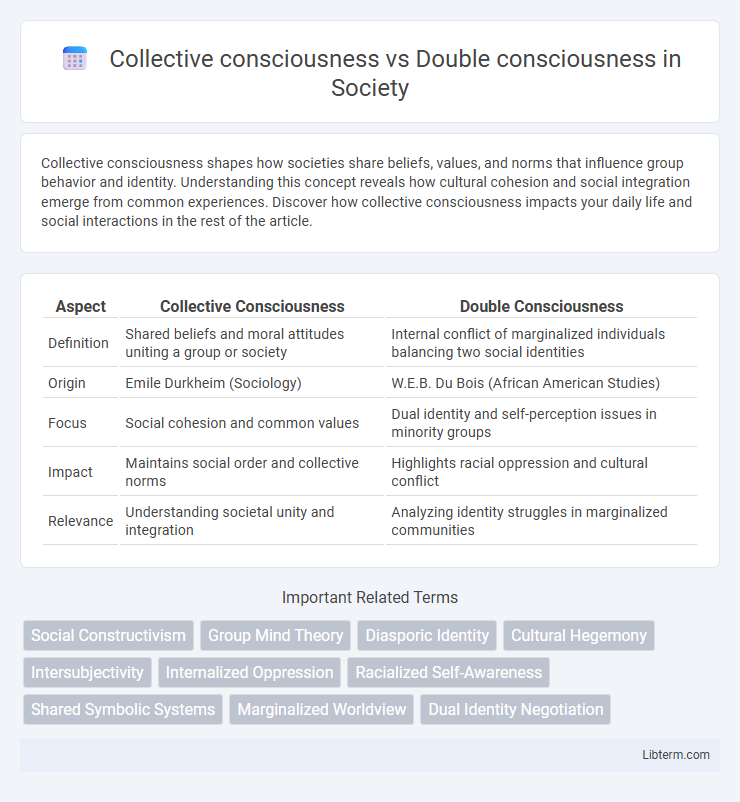Collective consciousness shapes how societies share beliefs, values, and norms that influence group behavior and identity. Understanding this concept reveals how cultural cohesion and social integration emerge from common experiences. Discover how collective consciousness impacts your daily life and social interactions in the rest of the article.
Table of Comparison
| Aspect | Collective Consciousness | Double Consciousness |
|---|---|---|
| Definition | Shared beliefs and moral attitudes uniting a group or society | Internal conflict of marginalized individuals balancing two social identities |
| Origin | Emile Durkheim (Sociology) | W.E.B. Du Bois (African American Studies) |
| Focus | Social cohesion and common values | Dual identity and self-perception issues in minority groups |
| Impact | Maintains social order and collective norms | Highlights racial oppression and cultural conflict |
| Relevance | Understanding societal unity and integration | Analyzing identity struggles in marginalized communities |
Understanding Collective Consciousness
Collective consciousness refers to the shared beliefs, values, and knowledge that shape social cohesion within a community, as theorized by Emile Durkheim. It emphasizes how individual identities are interconnected through cultural norms and collective experiences, fostering social solidarity. Understanding collective consciousness reveals the mechanisms by which societies maintain order and transmit cultural heritage across generations.
Defining Double Consciousness
Double consciousness, a concept coined by W.E.B. Du Bois, describes the internal conflict experienced by marginalized groups, especially African Americans, who navigate multiple social identities and perspectives simultaneously. It highlights the tension between one's self-perception and how society imposes an external identity, resulting in a fragmented sense of self. Collective consciousness, in contrast, refers to the shared beliefs and moral attitudes that unify a group, emphasizing social cohesion rather than internal identity struggles.
Historical Roots of Collective Consciousness
Collective consciousness, first conceptualized by Emile Durkheim, originates from the shared beliefs, morals, and attitudes that unify a society historically rooted in social cohesion and collective experiences. In contrast, W.E.B. Du Bois's theory of double consciousness emerges from the African American historical experience, describing the internal conflict of identity faced under systemic racism and marginalization. The historical roots of collective consciousness underscore the creation of social bonds through collective rituals and shared values that distinguish it fundamentally from the dual identity struggle embodied by double consciousness.
Origins of Double Consciousness Concept
The concept of double consciousness originates from W.E.B. Du Bois's 1903 work "The Souls of Black Folk," describing the internal conflict experienced by African Americans navigating a dual identity imposed by a racially divided society. Collective consciousness, a term coined by Emile Durkheim, refers to the shared beliefs, values, and norms that bind a community, contrasting with the individual psychological struggle inherent in double consciousness. Du Bois's double consciousness critiques the collective societal norms that marginalize black identity, highlighting a unique psychological trauma absent from Durkheim's sociological framework.
Key Theorists: Durkheim vs. Du Bois
Emile Durkheim's concept of collective consciousness emphasizes the shared beliefs and moral attitudes that unify society, forming a cohesive social fabric essential for societal stability. In contrast, W.E.B. Du Bois's theory of double consciousness highlights the internal conflict experienced by African Americans who navigate their identity through the lens of a racially prejudiced society, resulting in a dual self-perception. Both theorists address how individual identity is shaped by social forces, but Durkheim focuses on societal integration, while Du Bois explores racialized identity fragmentation.
Social Identity Formation in Groups
Collective consciousness refers to the shared beliefs, values, and norms that unify members of a group, fostering a cohesive social identity and influencing group behavior. Double consciousness, a concept coined by W.E.B. Du Bois, describes the internal conflict experienced by marginalized groups who navigate their self-perception through both their own perspective and the dominant society's view, complicating social identity formation. Both concepts highlight the dynamic interplay between individual and group identities, emphasizing how social identity in groups is shaped by collective norms and internalized societal perceptions.
Inner Conflict and Internalized Division
Collective consciousness refers to the shared beliefs and moral attitudes that unify a social group, fostering a sense of belonging and common identity, whereas double consciousness describes the internalized division experienced by marginalized individuals who perceive themselves through the conflicting perspectives of their own self-awareness and the dominant societal gaze. Inner conflict in double consciousness arises from navigating this dual self-perception, leading to a fragmented identity and psychological tension. In contrast, collective consciousness emphasizes social cohesion without the internalized division characteristic of double consciousness.
Collective Solidarity and Shared Values
Collective consciousness, a concept rooted in Durkheimian sociology, emphasizes the shared beliefs and moral attitudes that unify members of a society, fostering collective solidarity through common values and social norms. Double consciousness, introduced by W.E.B. Du Bois, highlights the internal conflict experienced by marginalized groups who navigate multiple social identities, complicating the sense of unified collective solidarity. While collective consciousness builds cohesion through shared values, double consciousness reveals the challenges of achieving solidarity within socially stratified or racially divided communities.
Navigating Dual Identities in Society
Collective consciousness represents the shared beliefs and values that unify members of a society, while double consciousness describes an individual's internal conflict stemming from belonging to marginalized groups navigating dominant cultural norms. Navigating dual identities involves balancing the internal self-perception shaped by collective societal expectations with the lived experience of being perceived through a segregated social lens. This dynamic challenges individuals to reconcile personal identity with societal pressures, influencing social behavior and community belonging.
Contemporary Relevance and Applications
Collective consciousness, rooted in Emile Durkheim's theory, emphasizes shared beliefs and values uniting societies, influencing contemporary social movements and digital communities. Double consciousness, coined by W.E.B. Du Bois, highlights the internal conflict experienced by marginalized groups navigating dominant cultural identities, relevant in discussions on racial identity and systemic inequality today. Both concepts are applied in contemporary sociology, psychology, and cultural studies to understand group dynamics, identity formation, and social justice initiatives.
Collective consciousness Infographic

 libterm.com
libterm.com